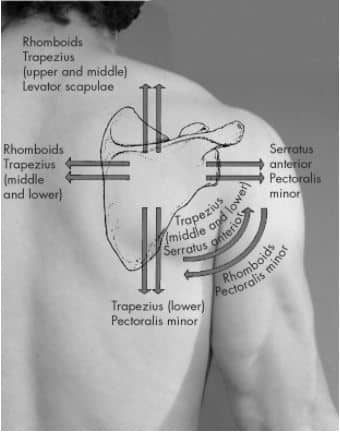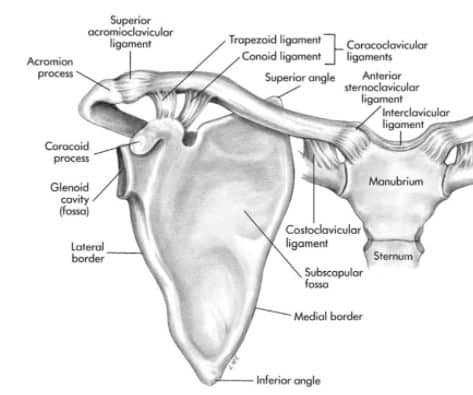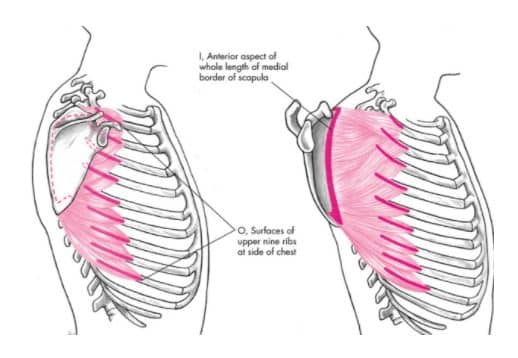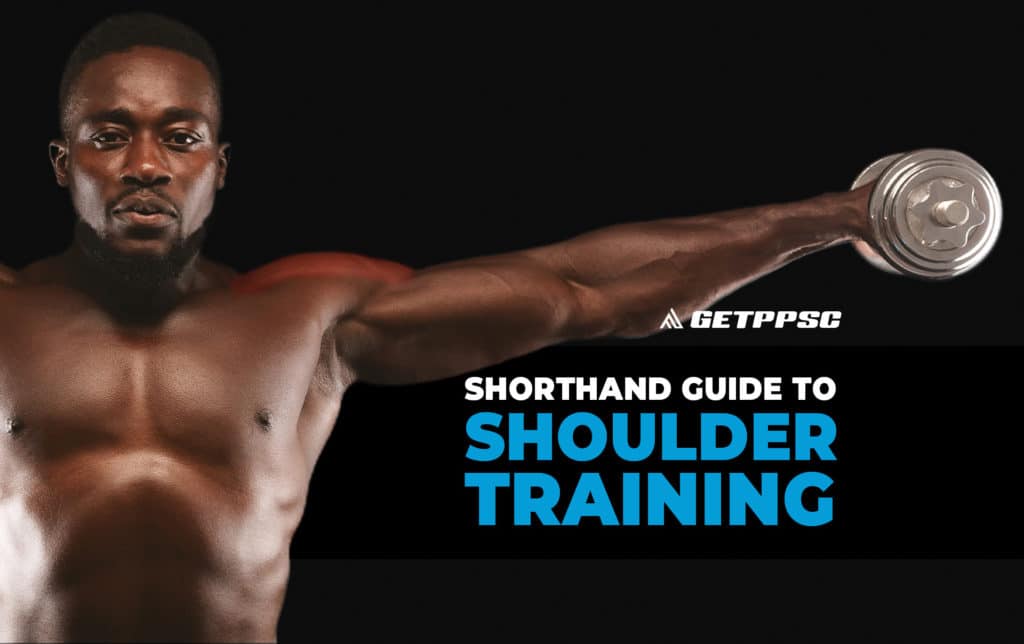Training for shoulder health can be complex…
Shoulder pain is a common and disabling complaint among many trainees. The reported annual incidence of shoulder pain in primary care is 14.7 per 1000 patients per year, with a lifetime prevalence of up to 70% (all numbers according to a study in the open access journal BMC Musculoskeletal Disorders).
The proper term for the shoulder joint is the “shoulder complex”, this is because the shoulder is actually composed of four joints, three real joints and one “pseudo” joint. There are over a dozen muscles that act on the shoulder complex & allow for the high variability in range of motion available to the shoulder complex.
There are a lot of moving parts when it comes to the shoulder complex, which can make training for shoulder health intimidating! My goal is to provide you with a deeper understanding of the anatomy of the shoulder complex, give you some guiding principles for training to optimize shoulder health, as well as address some common issues that can negatively impact training for shoulder health.
SHOULDER COMPLEX ANATOMY
The anatomy of the shoulder complex is well… complex. There are dozens of bony structures & even more muscles that act on the joint. The complexity is a necessary evil in order to create the most mobile joint in the body. You will always have this article to refer back too, so don’t stress about memorizing every muscle & how they act on the shoulder joint.
The important thing to understand here is that all of these individual parts of the shoulder complex must function together as a unit to create the high amounts of range of motion that the shoulder complex is capable of achieving.
For example, to create 170° – 180° of shoulder abduction, we need about 60° of scapular upward rotation, 25° of scapular elevation, and 95° of Glenohumeral abduction.
The shoulder complex consists of three true joints & one “pseudo” joint. The one “pseudo” joint, probably the most important of the four (in my opinion) is:
THE SCAPULOTHORACIC JOINT (a.k.a. the shoulder girdle):
Unlike the other three joints of the shoulder, the scapulothoracic joint is not a synovial joint. As the name “scapulothoracic” suggests, this joint is created by the scapula gliding along the thoracic rib cage. Movement at the scapulothoracic joint is key for proper centration of the glenohumeral joint.
PRIMARY MUSCLES AND ACTIONS FOR THE “ST” JOINT
The scapulothoracic joint is primarily acted upon by five major muscles, with one smaller muscle receiving honorable mention.
Low Traps: Adduct, Depress, and Upwardly Rotate the Scapula
Mid Traps: Elevate, adduct, and upwardly rotate the Scapula
Upper Traps: Elevate the Scapula extend Cervical Spine
Rhomboids: Adduct, Downward Rotation, and Elevation of the Scapula
Levator Scapula: Elevation of the Scapula
Pec Minor: Abduction, Downward Rotation, Depression of the Scapula
Serratus Anterior: Abduction and upward rotation of the Scapula
Honorable mention:
The Subclavius: which helps to depress the scapula by pulling down on the clavicle.
SCAPULOHUMERAL RHYTHM

If we want to achieve a proper overhead position, proper scapulothoracic motion (scapula gliding along the thoracic rib cage as the humerus moves away from the body) is key.
In general, for every 2° of arm flexion, we need about 1° of upward rotation from the scapulothoracic joint. Without proper movement from the scapulothoracic joint, the glenohumeral joint can only achieve about 90° of abduction. This is what makes the scapulothoracic joint so important for shoulder health!
Out of all of the primary muscles of the scapulothoracic joint, the serratus anterior is the most pivotal for proper scapulothoracic rhythm. The serratus originates on the rib cage & inserts on the anterior medial border of the scapula. The serratus keeps the scapula up against the rib cage and also assists in scapular abduction & upward rotation.
The three true joints of the shoulder complex are:

GLENOHUMERAL JOINT:
The ball of the humerus (arm bone) meets the glenoid fossa (socket) to form the glenohumeral joint. This ball & socket orientation of the glenohumeral joint allows for high degrees of mobility at the shoulder.
ACROMIOCLAVICULAR JOINT:
The acromion process is the most lateral & anterior aspect to the spine of the scapula (a.k.a. the shoulder blade). The acromioclavicular joint is where the acromion process meets the clavicle. This is a very common site of impingement & pain for many trainees.
& last but certainly not least-
STERNOCLAVICULAR JOINT:
Can you guess which two bones make up the sternoclavicular joint? That would be the sternum & the clavicle!
PRIMARY MUSCLES FOR THE GLENOHUMERAL JOINT
There are many muscles that act to move and stabilize the glenohumeral joint. This adds to the complexity of the joint.
Intrinsic Muscles & their actions:
Deltoid: Flexion, Abduction, Horizontal Abduction & Adduction, Diagonal Abduction & Adduction
Coracobrachialis: Horizontal Adduction, Diagonal Adduction
Teres Major: Extension, Adduction, Internal Rotation
Rotator Cuff Group & their actions: helps to keep ball of Humerus centrated in the socket of Glenoid Fossa
Supraspinatus: Abduction
Infraspinatus: External Rotation, Horizontal Abduction, Diagonal Abduction
Teres Minor: External Rotation, Horizontal Abduction, Diagonal Abduction
Subscapularis: Internal Rotation
Pectoralis Major: Flexion, Extension (lower pec), Abduction (upper pec), Adduction (lower pec), Internal Rotation, Horizontal Adduction, Diagonal Adduction
Latissimus Dorsi: Extension, Adduction, Internal Rotation
Triceps Brachii: Diagonal Abduction
Biceps Brachii: Diagonal Adduction

FOUR KEYS TO OPTIMIZING SHOULDER HEALTH
MAINTAIN PROPER SCAPULOHUMERAL RHYTHM
Oftentimes, shoulder issues occur because of a scapula that cannot glide along the rib cage. Train open chain scapular variations at least twice as much as closed chain variations.
PULL 3-4X MORE THAN YOU PUSH
We tend to prioritize the “mirror muscles” in our training, the pecs & biceps. Program more pulls than pushes, and even more horizontal pulls (rowing exercises) than vertical pulls (pull downs).
TRAIN THE UPPER BACK OFTEN (3-5x a week)
The Rusin Banded Tri-Set (check it out here) is great for this. We want to train the upper back OFTEN. If you follow JR & his content, you’ve probably seen him talk about training the upper back DAILY.
TRAIN UNILATERALLY (MINIMUM 1 PUSH/PULL PER WORKOUT)
It is very possible that you have an asymmetry between your shoulders, especially if you are a current or former overhead throwing athlete. Allow the two shoulder joints to move independently of each other for a minimum of one push & pull movement per workout.
EXERCISES FOR SCAPULOHUMERAL RHYTHM
Here are 5 exercises to focus on scapular movement in conjuction with the upper arms for healthier and smoother movement.
1. LAZY BEAR
• Make sure hands begin directly under the shoulders
• Tighten up the Glutes and Hamstrings
• Allow Breathwork to move the Ribcage
2. 90/90 SUPINE ARM REACH
• Begin with a strong pillar position
• Prioritize the Spine position with movement of the limbs
• Only move the limbs as far as you can maintain rigid position
3. WALL SLIDES
• Smooth motion along the wall in key
• Maintain tall spine position throughout the movement without the Ribs flaring
4. HAND RELEASE PUSH-UPS
• Begin in a strong Push-Up position with neutral spine
• Arms should move around 45° from the Torso for proper centration (varies from person to person)
• Maintain tension while the hands release at the bottom of the position
5. EXAGGERATED TRX ROW
• Create Full Body irradiation from heels through fingertips
• Drive the elbows back to pull upward in the movement
• Allow the shoulder blades to move freely under control
COMMON ISSUES
ISSUE 1
An overused cue in the fitness industry is “pack your shoulder blades”. This is great if you’re looking to stabilize your shoulders under a heavy barbell bench press. But if a majority of your pressing work does not allow for free moving scaps, you’re playing a risky game.
FIX
Train open chain scapular variations at least twice as much as closed chain variations. Think more push ups & cable presses & less barbell bench press. Keyword, LESS, no need to throw your barbell out.
ISSUE 2
Another common issue I see as it pertains to proper scapulothoracic rhythm is an over reliance on the upper traps, especially with rows! This reliance on the upper traps leads to an anterior humeral glide. This is when the ball of the humerus rolls forward & up against the front of the shoulder capsule. This can cause a lot of pain in the front & back of the shoulder, especially at the acromioclavicular joint!
FIX
Screen clients for proper patterning of scapular protraction & retraction. One of my favorite exercises to teach this is thoracic glides. This exercise takes the scapulas through full protraction & retraction.
ISSUE 3
During a weekend at a PPSC course, we go over how to find an individual’s humeral carrying angle. This is important as shoulder joints, similar to hip joints, vary from individual to individual.
The structure of the acromion process exists on a spectrum:
Flat -> Curved -> Hooked
As you can see in the picture below, the orientation of the acromion process can vastly differ, affecting the amount of sub acromial (below the acromion process) space available. It’s possible to have a client with two completely different orientations of the acromion process from left to right, possibly a structural adaptation due to the imposed demands placed on the structure.
FIX
Make sure to test for a clients humeral carrying angle to avoid training potentially vastly asymmetrical shoulder joints, symmetrically.
CLOSING THOUGHTS
Just because shoulder anatomy may be complex, training to optimize shoulder health does not have to be. I strongly believe that most shoulder pain occurs due to improper scapulothoracic rhythm. To remedy this, I can not recommend the core/breathing drills (Lazy Bear & 90/90 Supine Arm Reach) enough!
Don’t get caught up in memorizing every joint & muscle of the shoulder complex, you can always return to this article for a refresher.
Focus on training for shoulder health on a context dependent basis, using the four keys to optimizing shoulder health as guiding principles rather than end all be all protocols.
Training to optimize shoulder health does not mean neglecting heavy pressing & pulling. There are many loading options that allow the scapula’s to move freely, my favorite being chain loaded movements & cable work!
Train the shoulder complex hard, heavy, often & intelligently for sustained upper body gains!




